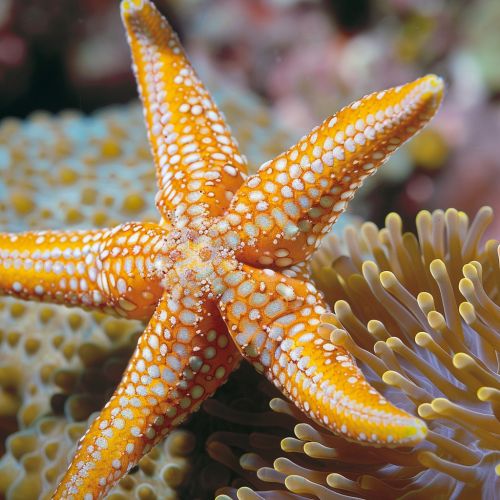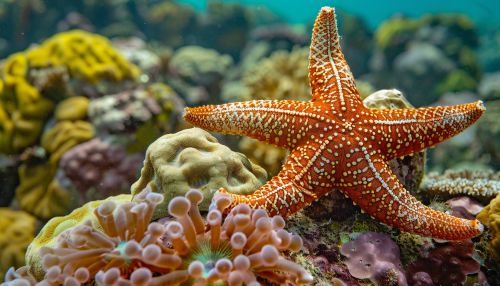Deuterostome
Introduction
Deuterostomes are a major clade of animals that are characterized by their embryonic development. The term "deuterostome" is derived from the Greek words "deuteros," meaning second, and "stoma," meaning mouth, indicating that the mouth forms secondarily to the anus during embryonic development. This group includes some of the most complex and diverse animals, including the chordates (which encompass vertebrates), echinoderms (such as starfish and sea urchins), and hemichordates (acorn worms and pterobranchs).
Embryonic Development
One of the defining characteristics of deuterostomes is their unique embryonic development. During the early stages of development, the embryo undergoes a process called gastrulation, where it forms a structure known as the blastopore. In deuterostomes, the blastopore becomes the anus, while the mouth forms later. This is in contrast to protostomes, where the blastopore becomes the mouth.
Cleavage
Deuterostomes exhibit radial, indeterminate cleavage during early embryonic development. This means that the cells divide parallel or perpendicular to the axis of the embryo and the fate of each cell is not determined early on. This allows for greater flexibility in development and the potential for identical twins.
Coelom Formation
The coelom, or body cavity, in deuterostomes forms through a process called enterocoely. During this process, the mesoderm (middle layer of embryonic tissue) buds off from the wall of the archenteron (primitive gut) to form the coelom. This is another distinguishing feature from protostomes, which typically form the coelom through schizocoely, where the mesoderm splits to create the body cavity.
Phylogeny and Classification
Deuterostomes are divided into several major phyla: Chordata, Echinodermata, and Hemichordata. Each of these phyla has unique characteristics and evolutionary significance.
Chordata
The phylum Chordata includes animals that possess a notochord, a dorsal hollow nerve cord, pharyngeal slits, an endostyle, and a post-anal tail at some point during their development. This group is further divided into three subphyla: Vertebrata (animals with backbones), Cephalochordata (lancelets), and Urochordata (tunicates).
Echinodermata
Echinoderms are marine animals known for their radial symmetry, a water vascular system, and an endoskeleton made of calcareous plates. This phylum includes starfish, sea urchins, sand dollars, and sea cucumbers. Echinoderms play a crucial role in marine ecosystems and have a unique mode of locomotion using tube feet.
Hemichordata
Hemichordates are a small phylum of worm-like marine animals that share some characteristics with both chordates and echinoderms. They are divided into two classes: Enteropneusta (acorn worms) and Pterobranchia. Hemichordates possess pharyngeal slits and a stomochord, which is similar to the notochord found in chordates.


Evolutionary Significance
Deuterostomes are of great evolutionary significance due to their complex body plans and diverse forms. The evolutionary relationships among deuterostomes have been extensively studied using both morphological and molecular data. The common ancestor of deuterostomes is believed to have lived over 500 million years ago during the Cambrian period.
Fossil Record
The fossil record of deuterostomes provides crucial insights into their early evolution. Notable fossil discoveries include the Cambrian Burgess Shale and Chengjiang biota, which have yielded well-preserved specimens of early deuterostomes. These fossils help to understand the morphological diversity and evolutionary transitions within the group.
Molecular Phylogenetics
Molecular phylogenetics has revolutionized the study of deuterostome evolution. By analyzing DNA sequences, scientists have been able to reconstruct the evolutionary relationships among deuterostomes with greater accuracy. These studies have confirmed the monophyly of deuterostomes and have provided insights into the timing and pattern of their diversification.
Developmental Biology
The study of deuterostome development has provided significant insights into the mechanisms of animal development and evolution. Research on model organisms such as the sea urchin, zebrafish, and mouse has revealed conserved genetic pathways that regulate development.
Gene Regulatory Networks
Gene regulatory networks (GRNs) are complex networks of interacting genes that control the development of an organism. In deuterostomes, GRNs have been extensively studied in echinoderms and chordates. These studies have revealed that many key developmental genes are conserved across deuterostomes, suggesting a common evolutionary origin.
Evolution of Developmental Pathways
Comparative studies of developmental pathways in deuterostomes have provided insights into the evolution of complex body plans. For example, the evolution of the notochord and dorsal nerve cord in chordates is believed to have involved the co-option of existing genetic pathways. Similarly, the evolution of the water vascular system in echinoderms involved the modification of ancestral structures.
Genomics and Genetics
The advent of genomics has provided new tools for studying the genetics and evolution of deuterostomes. The sequencing of genomes from various deuterostome species has revealed important insights into their genetic makeup and evolutionary history.
Genome Sequencing
The genomes of several deuterostome species have been sequenced, including the sea urchin, amphioxus, and various vertebrates. These genomic data have provided valuable information on gene content, genome organization, and evolutionary relationships.
Comparative Genomics
Comparative genomics involves comparing the genomes of different species to identify conserved and divergent genetic elements. In deuterostomes, comparative genomics has revealed conserved gene families and regulatory elements that are involved in key developmental processes. These studies have also identified lineage-specific innovations that contribute to the diversity of deuterostomes.
Ecology and Behavior
Deuterostomes occupy a wide range of ecological niches and exhibit diverse behaviors. Understanding the ecology and behavior of deuterostomes is important for understanding their role in ecosystems and their evolutionary adaptations.
Marine Ecosystems
Many deuterostomes, such as echinoderms and hemichordates, are marine organisms that play important roles in marine ecosystems. Echinoderms, for example, are important grazers and predators that influence the structure of marine communities. Hemichordates are important bioturbators that affect sediment structure and nutrient cycling.
Terrestrial and Freshwater Ecosystems
While most deuterostomes are marine, some groups, such as vertebrates, have successfully colonized terrestrial and freshwater environments. Vertebrates exhibit a wide range of ecological adaptations, from the amphibious lifestyle of frogs to the aerial lifestyle of birds and the terrestrial lifestyle of mammals.
Behavioral Adaptations
Deuterostomes exhibit a wide range of behavioral adaptations that enhance their survival and reproduction. For example, echinoderms use their tube feet for locomotion and feeding, while vertebrates exhibit complex behaviors such as social interactions, communication, and tool use.
Conservation and Threats
Many deuterostome species are facing threats due to human activities, such as habitat destruction, pollution, and climate change. Conservation efforts are important for protecting these species and maintaining biodiversity.
Threats to Marine Deuterostomes
Marine deuterostomes, such as echinoderms and hemichordates, are particularly vulnerable to threats such as overfishing, habitat destruction, and ocean acidification. These threats can have significant impacts on marine ecosystems and the species that depend on them.
Conservation Efforts
Conservation efforts for deuterostomes include habitat protection, pollution control, and species-specific management plans. For example, marine protected areas can help to preserve critical habitats for echinoderms, while captive breeding programs can help to conserve endangered vertebrate species.
